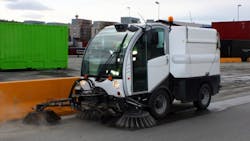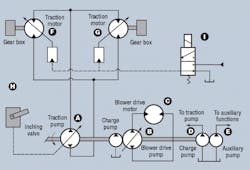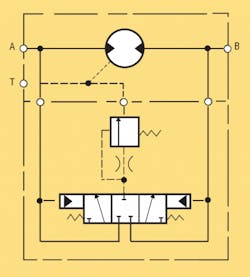Tandem pumps power street sweeper
Self-propelled hydraulic sweepers are familiar sights on city and suburban streets. Although they perform what appear to be relatively unsophisticated and menial jobs, the sweepers accomplish these tasks in minimal time. In one pass, they can sweep up stones, dirt, leaves, paper goods, glass, metal parts, and other waste materials. Sweeper brushes move the material from the street surface and direct it into the machine. A powerful fan inside the machine works like a giant vacuum cleaner to blow the debris into a collection hopper. The hopper is later dumped at a transfer station for subsequent disposal.
Dirt tolerance a must
Because of the heavy demands placed on these machines and the dirty environment in which they operate, some sweepers had a reputation as maintenance intensive — primarily from lack of regular servicing. The street sweeper industry began shedding this image of dated styling, high wear, and the need for frequent maintenance years ago and became more high-technology oriented. Designers have reduced the number of wear components in a typical sweeper and also improved the efficiency and reliability of hydraulics not only for propulsion, but also to rotate the brooms and blower assembly that are the heart of the cleaning system.
Sweepers typically use hydraulic power for all majors functions — hydrostatic propulsion drive, brush and fan rotation, and linear motion for positioning and dumping. One popular design uses a tandem piston pump and a tandem gear pump assembly. Referring to the schematic, section A of the tandem piston pump supplies pressurized fluid to the hydrostatic transmission circuit that propels the sweeper. The second section, pump B, drives hydraulic motor C, which powers the blower. Section D of the tandem gear pump assembly charges pump A, and Section E supplies auxiliary functions on the sweeper. Another gear pump charges pump B.
The tandem piston pump assembly includes integral high-pressure relief valves. An override on traction pump Ais set to a predetermined pressure to ensure that pressurized fluid from the pump does not flow through its relief valve for long periods. In blower drive pump B, relief valves are set at proportional pressures needed to run the blower at required speeds. This pump circuit does not require a pressure override valve because if the blower inlet plugs up — as can be anticipated in a street sweeper — system pressure would drop as work decreases, eliminating the possibility of operating the blower drive pump flowing over the relief valve.
The hydrostatic transmission for propulsion consists of electrically controlled, bi-directional over-center pump Asupplying pressurized fluid to traction motors Fand Gpiped in parallel. The traction motors drive the rear wheels through gear boxes, while the unpowered front wheels steer the vehicle.
The operator chooses forward or reverse travel or neutral by actuating a selector in the sweeper cab. The selector controls travel direction by energizing the appropriate non-proportional solenoid on pump A. The lever on valve H — connected to the vehicle’s accelerator pedal — controls travel speed.
Motors F and G have standard 2-point hydraulic pilot controls. Valve I shifts the motors to maximum displacement for sweeping and minimum displacement for travel. Motor G has an integral flushing valve and also a built-in induction pickup that measures drive shaft speed for the speedometer.
The blower system is powered by variable-displacement axial-piston pump B, which is equipped with an electrohydraulic proportional valve, similar to that used with pump A. Fixed-displacement motor C, drives the blower. A bent-axis piston motor is often used here because of its high volumetric efficiency. It also has an integral 3-position, 3-way flushing valve, consisting of a shuttle spool that picks up the lower pressure signal of the loop and a relief valve that ensures that charge pressure is maintained in the loop. An orifice built into the relief valve limits flow to the motor case. The arrangement is identical to that of traction motor G.



